Did you know that only 9% of marketing professionals worldwide evaluate the performance of their existing content strategy as “excellent”?
The biggest challenge faced by over half of the people we surveyed last year is creating content that brings significant traffic to their websites and generates quality leads.
That’s why, this year, SEMrush aimed to find out how to build an effective content marketing funnel that attracts and converts by conducting a survey among 350 marketers across the globe.
And today we’re excited to share the new survey results with you.
The full report reveals the top characteristics of effective content marketing funnels that work, featuring the:
- Top performing content types for each funnel stage.
- Most efficient channels for content distribution.
- Top content and funnel efficiency metrics.
- Top tactics to drive audiences to the next funnel stage.
- And a lot more stats.
We hope that our findings will help you find the weak points in your current content funnel, gather some ideas to test at every stage, and strengthen your overall content strategy.
Let’s get straight to the main results of this report now!
Content Marketing Funnel Overview
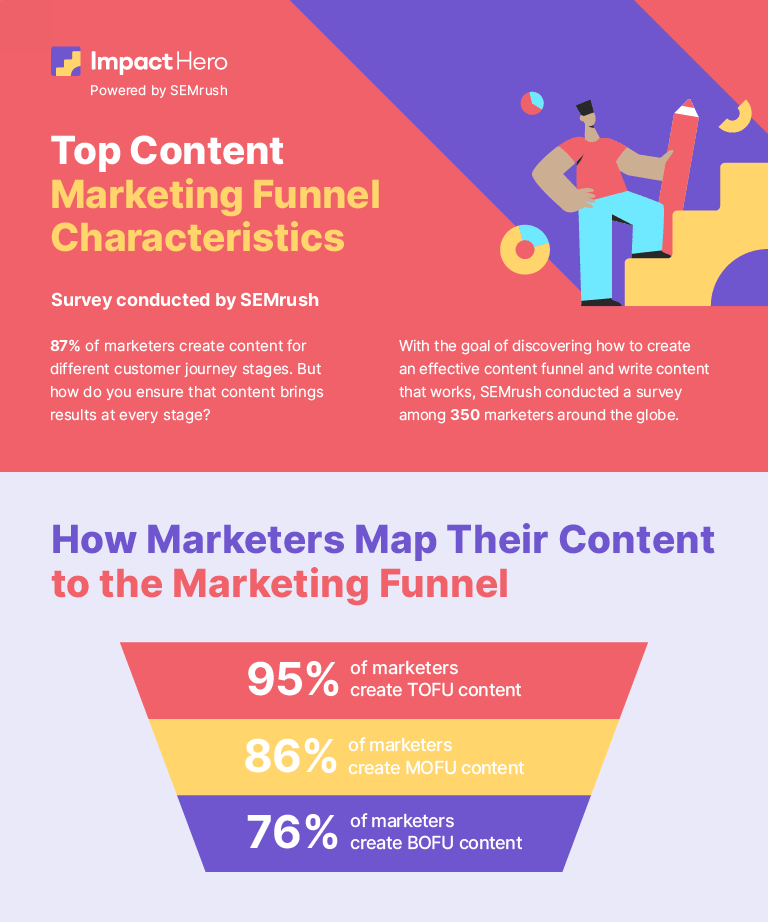
Though the vast majority (87%) of marketers create content for different customer journey stages, the top of the funnel remains the most popular one – 95% of marketers create TOFU content.
Then comes the middle of the funnel (MOFU), covered by 86% of our respondents.
Finally, 76% of the survey participants create bottom-of-the-funnel (BOFU) content.
These figures prove the idea that marketers support their audiences with content throughout the entire customer journey. Content is expected to attract the attention of potential customers, explain the product service value, and close the sale afterward.
“87% of marketers rely on content throughout different stages of the customer journey, while half of them find it challenging to encourage audiences to move to the next funnel stage.”
TOFU Content Top Stats
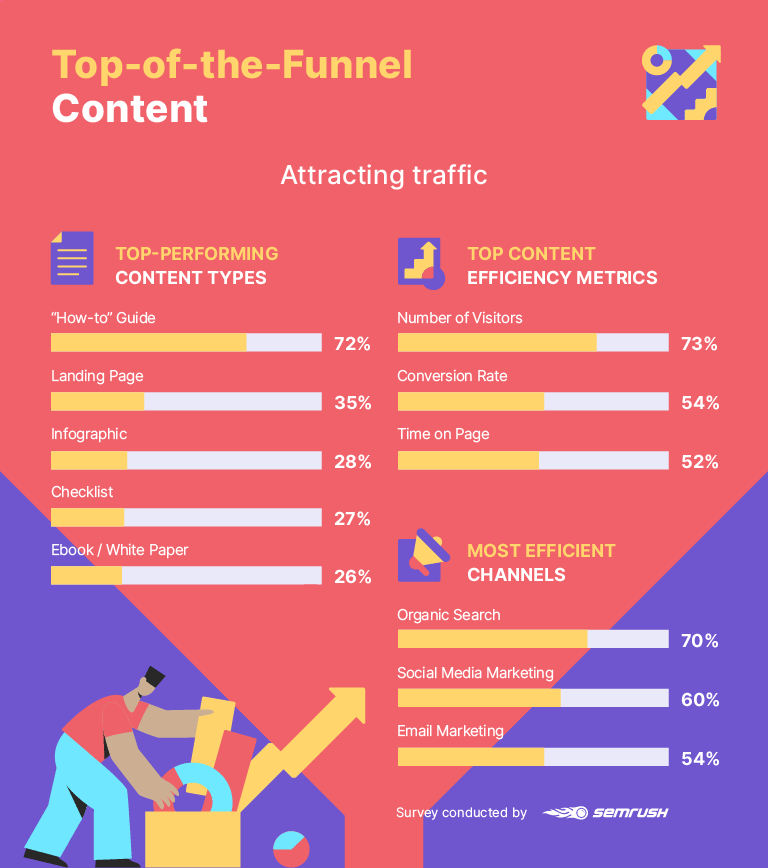
According to 70% of our respondents, organic search is the most efficient channel in attracting traffic at this funnel stage. And this is quite logical, as nowadays search engines have become the first place where people search for answers to their pains and questions.
Social media marketing and email marketing are the channels mentioned by 60% and 54% of marketers, respectively, which highlights the importance of delivering value through several touchpoints with audiences.
72% of the survey participants described “How-to” guides as an absolute leader at the top of the marketing funnel. This shows that the marketers’ focus shifted from straightforward advertising of the product to providing an exact answer to the potential customer query.
However, the importance of such tried and tested formats as landing pages (mentioned by 35% of marketers), as well as infographics and checklists (selected by 28% and 27% of marketers, respectively), did not diminish either. The latter two deliver information in a short and easy-to-understand form, and are designed to help website visitors clarify the problem they’re coping with and determine the main steps to solving it.
It’s no surprise that with the above formats our respondents use the number of visitors as their core metric (73%) to evaluate content success. Then comes conversion rate with 54% of the votes and time on page with 52%.
MOFU Content Top Stats
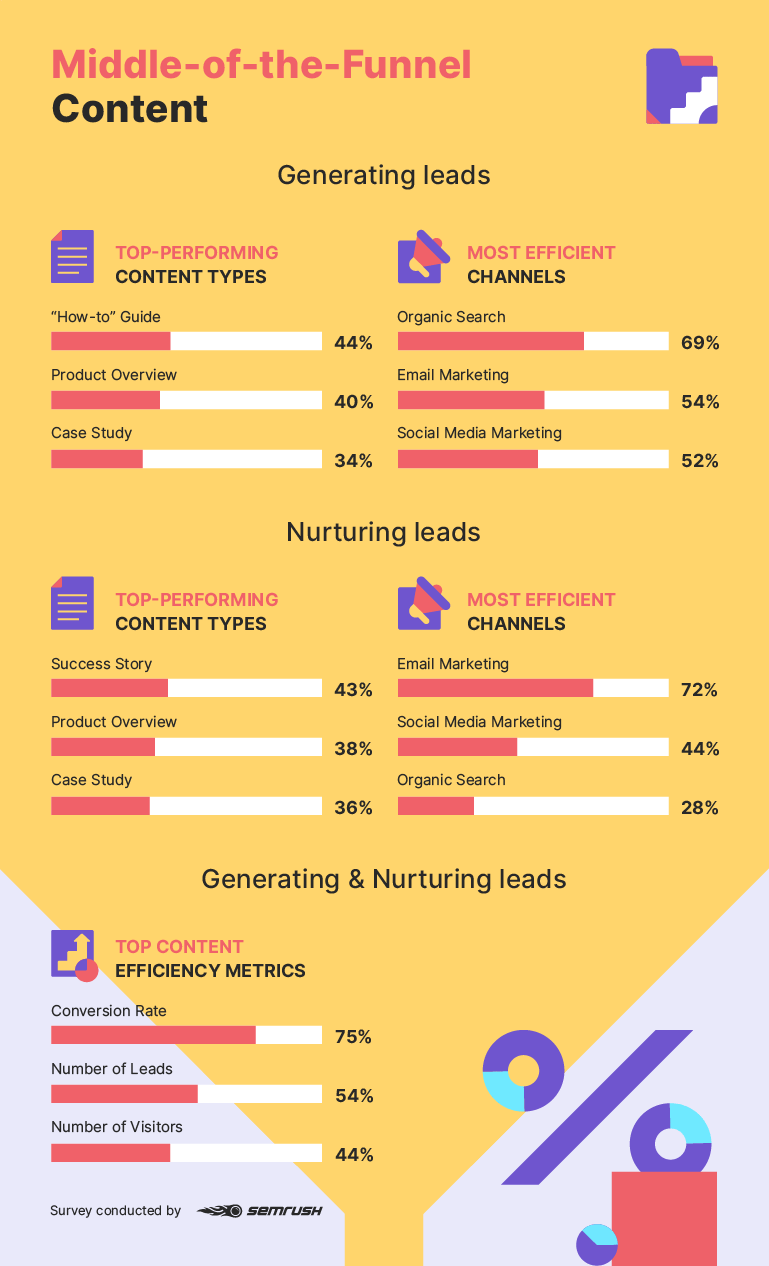
Surprisingly, here, “How-to” guides also work best to generate leads, according to 44% of our survey participants. However, these are logically followed by more product-specific and application-oriented formats like product overviews (40%) and case studies (34%). This shows that they see the main value of the product in its usability and effectiveness for potential customers’ businesses.
While organic search remains the most efficient (69%) channel for generating leads, followed by email marketing (54%) and social media marketing (52%), lead nurturing is carried out mostly via emails (72%).
Moreover, when a website visitor becomes a lead, 43% of marketers switch to success stories, 38% to product overview, and 36% to case studies to push these leads towards conversion.
That’s why conversion rate was chosen as the key metric for content efficiency by 75% of our respondents, along with number of leads (54%) and number of visitors (44%).
BOFU Content Top Stats
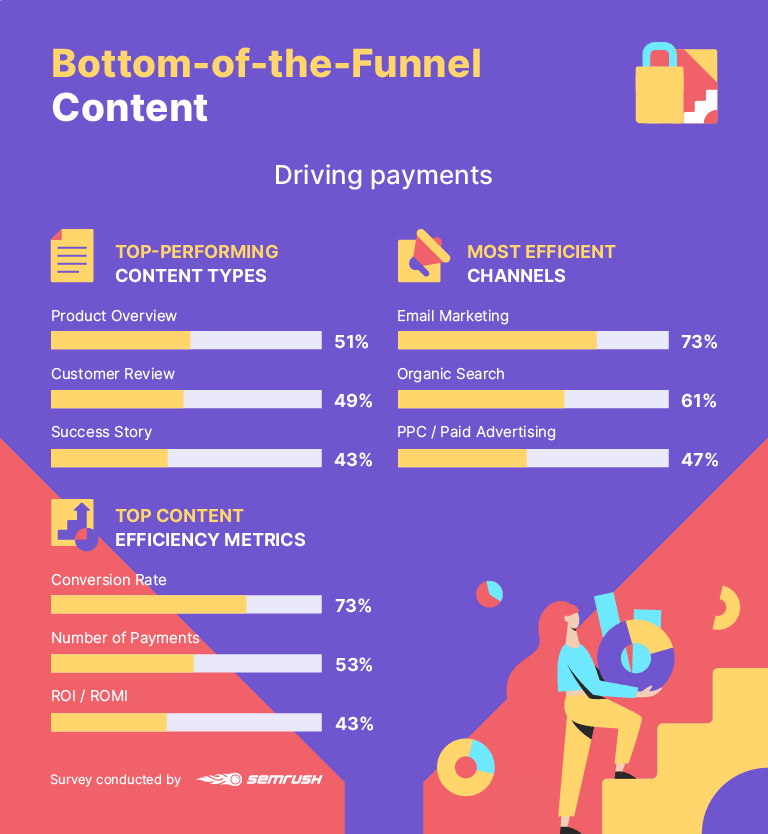
As the deal moves to its closure, 51% of marketers rely on the product overview as the main factor that drives payments, trying to explain the value they deliver in every detail.
Other arguments for the purchase are believed to be found in customer reviews (49% of votes) and success stories (43% of votes).
At this stage, marketers tend to give more priority to user-created content, hoping that the experiences and positive feedback of existing customers will help convert prospective ones.
As for the channels that drive payments, email marketing turns out to be most effective (73%). Then comes organic search (61%) and paid advertising (47%), which proves that strong content is capable of striking you a deal overnight.
It’s no surprise that at the bottom of the funnel the majority (73%) of marketers use conversion rate and other income-related metrics such as the number of payments (53%) and ROI / ROMI (43%) to measure their success.
Tactics Used to Build an Effective Content Marketing Funnel
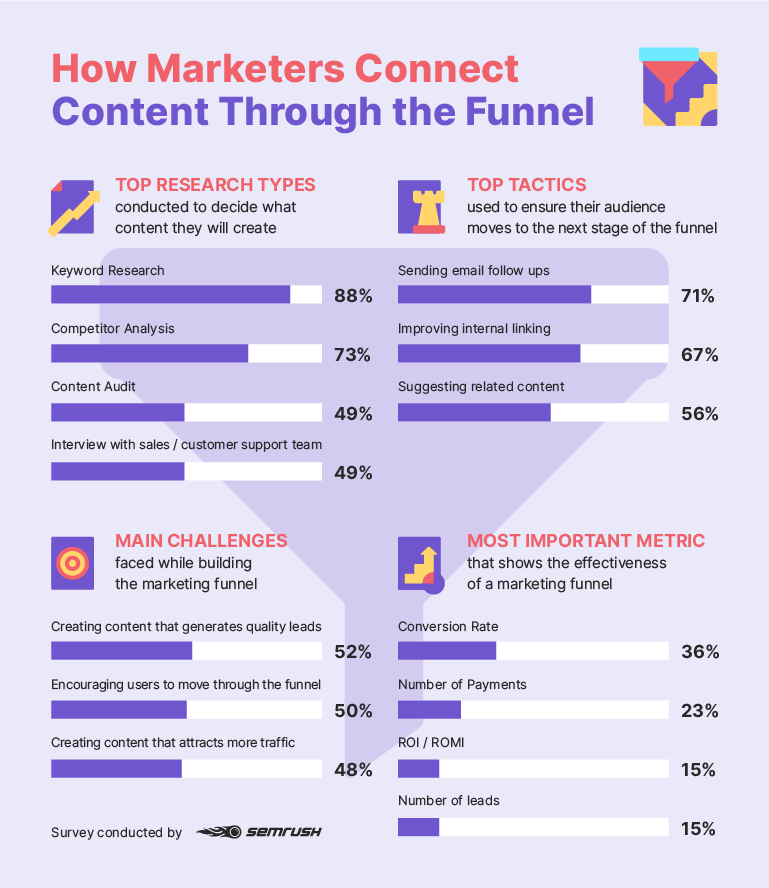
In the last part of the survey, we tried to find out how marketers decide which content to create for each stage of the funnel, and how they follow and interconnect it throughout the stages.
We learned that the absolute majority (88%) decide what content to create based on keyword research, and 73% rely on competitor analysis. Almost half of respondents (49%) use in-house knowledge and results to decide on what content to create – they conduct content audits and refer to the sales or customer support team.
Encouraging prospects to move through the funnel was considered one of the most challenging tasks when building a funnel by 50% of our respondents. 71% of them use email follow-ups to facilitate the process, 67% try to improve internal links and make the content easier to find, and 56% suggest related content to answer more specific queries.
Other serious challenges mentioned are creating content that generates quality leads (52%) and creating content that attracts traffic (48%).
As for the effectiveness of the funnel as a whole, 36% of the survey participants measure it by conversion rate, 23% the number of payments, and 15% by the number of leads and ROI / ROMI.
Survey Methodology
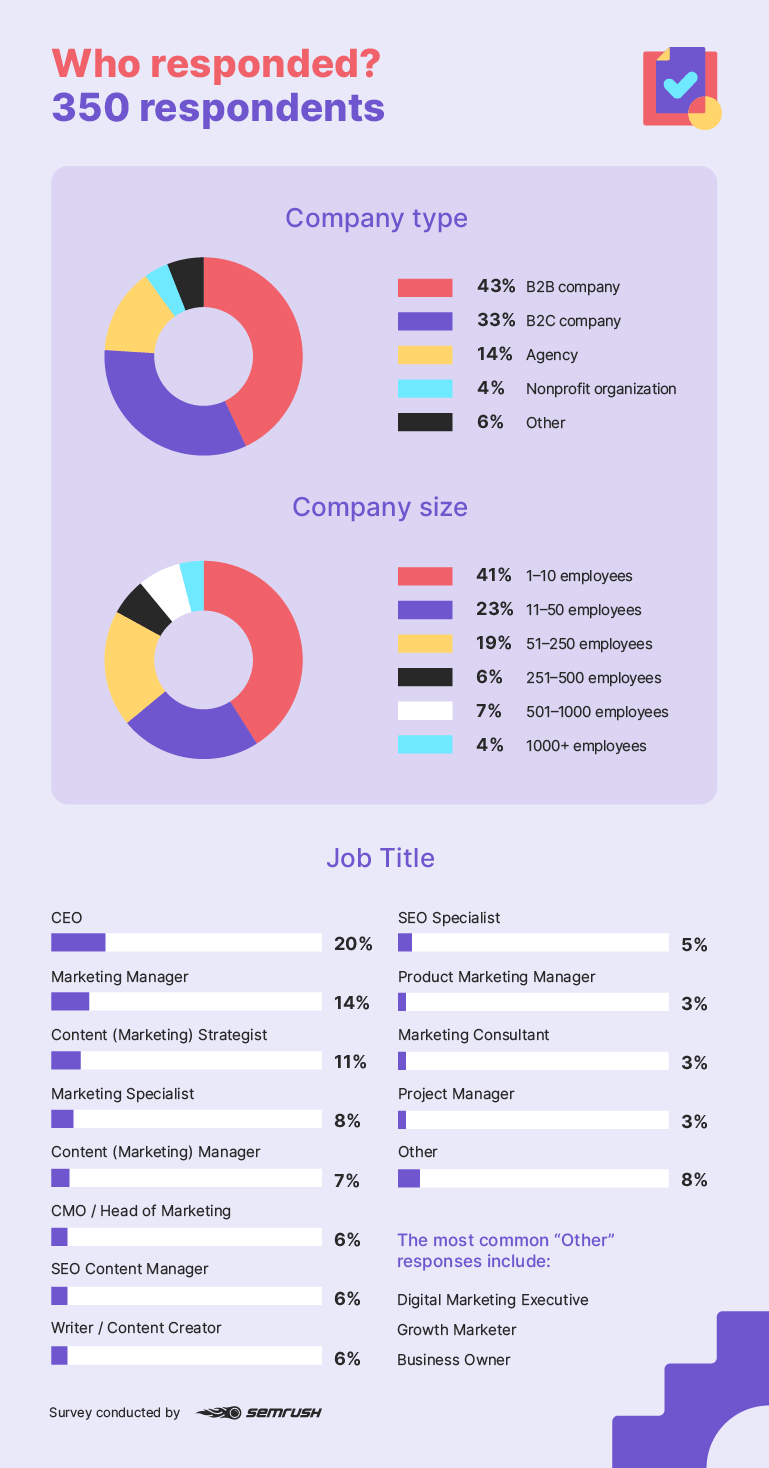
We asked 350 employees of digital marketing agencies, nonprofits, and other organizations all over the world to share their content marketing expertise.
The majority of our respondents (41%) work for small businesses (companies of 1-10 employees), which are mostly either B2B (43%) or B2C (33%) companies.
If you’d like to learn more about the funnels they build, check out the full “Survey Results on Building an Effective Content Marketing Funnel” published on the SEMrush blog.
Measure Your Content Marketing
Effectiveness with ImpactHero by SEMrush
The opinions expressed in this article are the sponsor's own.


![Anatomy of a Powerful Content Marketing Funnel [SEMrush Survey Stats]](https://www.searchenginejournal.com/wp-content/uploads/2020/08/abstract-5f46799b2682c.jpg)
